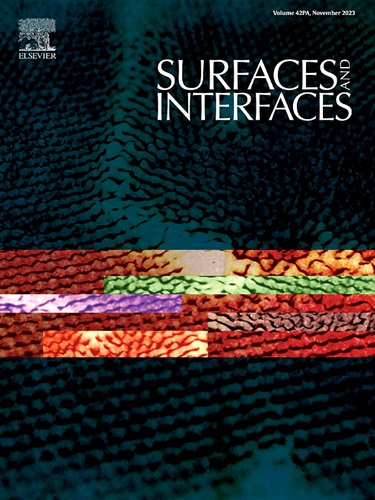Exploring the impact of tin addition on structural, morphology, dispersion, photovoltaic, linear, and nonlinear optical properties of thermally evaporated polycrystalline thin SnxSb2-xSe3 films
IF 5.7
2区 材料科学
Q2 CHEMISTRY, PHYSICAL
引用次数: 0
Abstract
This article focuses on preparing polycrystalline SnxSb2-xSe3 thin films (0.0 ≤ x ≤ 2.0 at.%) using the thermal evaporation process and investigating their optical and dispersion properties. These films were deposited on thoroughly-cleaned glass slides at a deposition rate of 1 nm/s, achieving a thickness of approximately 620 nm. The SnxSb2-xSe3 films were analyzed using X-ray diffraction analysis, energy-dispersive X-ray spectroscopy, field-emission scanning electron microscopy, UV–Vis-NIR spectrophotometry, and photovoltaic (I-V) measurements. The thickness (d) and refractive index (n) of thin films were determined using Swanepoel's envelope technique, with n-values at a wavelength of 800 nm increasing from 2.749 to 3.619, while d-values closely matched the controlled thickness of ≈ 620 nm. The single effective oscillator approach was successfully employed to obtain dispersion and single oscillator energies (Ed and Eo), revealing a decrease in Ed from 7.619 eV to 6.858 eV and a reduction in Eo from 4.783 eV to 4.342 eV. Various dispersion indices were calculated and analyzed using the energy values of Ed and Eo, and Sellmeier's parameters were also investigated. The static refractive index of the films increased from 2.106 to 2.276 as the Sn-content increased. The absorption coefficient ranged between 104 and 105cm-1. Optical bandgap energy values, determined using Tauc's plots, decreased from 1.166 eV to 1.048 eV. The band tail width, measured using Urbach's method, increased from 0.078 eV to 0.155 eV. Additionally, the study explored various nonlinear optical parameters, which were thoroughly discussed. The hot probe method demonstrated that the SnxSb2-xSe3 films are p-type semiconductors. Conversely, the ITO/ZnS/SnxSb2-xSe3/Au heterojunction was synthesized. The photovoltaic analysis demonstrates that as the tin ratio boosts, the efficiency of heterojunction is enhanced from 3.49 % to 7.08 %. Thus, the obtained results indicate these films have many potential applications in optical, optoelectronic, clean and renewable energy, and photovoltaic fields.

求助全文
约1分钟内获得全文
求助全文
来源期刊

Surfaces and Interfaces
Chemistry-General Chemistry
CiteScore
8.50
自引率
6.50%
发文量
753
审稿时长
35 days
期刊介绍:
The aim of the journal is to provide a respectful outlet for ''sound science'' papers in all research areas on surfaces and interfaces. We define sound science papers as papers that describe new and well-executed research, but that do not necessarily provide brand new insights or are merely a description of research results.
Surfaces and Interfaces publishes research papers in all fields of surface science which may not always find the right home on first submission to our Elsevier sister journals (Applied Surface, Surface and Coatings Technology, Thin Solid Films)
 求助内容:
求助内容: 应助结果提醒方式:
应助结果提醒方式:


